Floralis Generic, an imposing sculpture in the Palermo neighborhood.
It is a metal sculpture 20m high, which is located in the United Nations Square.
Donation made by its author, the Argentine architect Eduardo Catalano.
Floralis Generic, an imposing sculpture in the Palermo neighborhood.
It is a metal sculpture 20m high, which is located in the United Nations Square.
Donation made by its author, the Argentine architect Eduardo Catalano.
Lezama Square (Parque Lezama), the most luxurious green space in the city of Buenos Aires.
It is a traditional walk in the City of Buenos Aires. Located in the San Telmo neighborhood, on the border with La Boca and Barracas, between Defensa, Brasil, Av. Paseo Colón and Av. Martín García streets.
San Martín Plaza, one of the oldest in the city of Buenos Aires, in the heart of Retiro.
It is one of the few green spaces where several historical events took place.
In 1807, a combat was carried out, which ended in victory. In 1812, San Martín installed the barracks of the Horse Grenadier Regiment, so in 1878, before the centenary of his birth, he was commemorated by giving his name to this beautiful and enormous space. In 1942 it was declared a Historic Place of the city.
Botanical Garden, an immense space, full of nature, in the heart of Palermo.
If you like plants, trees and vegetables, this place is special for you!
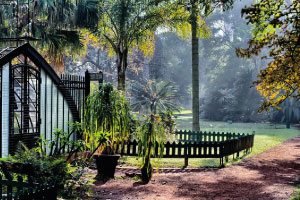 With more than 7 hectares, it is the center of 6,000 plant species. As you walk through the Garden, each species has its name so that you can learn about each of the varieties found there.
With more than 7 hectares, it is the center of 6,000 plant species. As you walk through the Garden, each species has its name so that you can learn about each of the varieties found there.
Located on Av. Santa Fe and República Árabe Syria, it is an immense space of pure air, ideal for a day of walking, relaxation and learning.
It has 5 greenhouses, a botanical library, three gardens with French, Oriental and Roman styles, a herbarium and, many times, you will be able to find art samples in its beautiful English-style house.
Entrance is free and open.
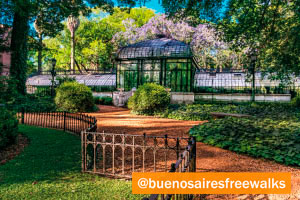 We provide you with the garden hours so that you can plan your visit to the place well. On Mondays it is closed for cleaning and specific care. In summer (September 22 to April 21) it opens Tuesday to Friday from 8 a.m. to 6:45 p.m. and Saturday, Sunday and holidays from 9:30 a.m. to 6:45 p.m. In winter (April 22 to September 21) Tuesday to Friday open from 8 a.m. to 5:45 p.m. and Saturday, Sunday and holidays from 9:30 a.m. to 5:45 p.m.
We provide you with the garden hours so that you can plan your visit to the place well. On Mondays it is closed for cleaning and specific care. In summer (September 22 to April 21) it opens Tuesday to Friday from 8 a.m. to 6:45 p.m. and Saturday, Sunday and holidays from 9:30 a.m. to 6:45 p.m. In winter (April 22 to September 21) Tuesday to Friday open from 8 a.m. to 5:45 p.m. and Saturday, Sunday and holidays from 9:30 a.m. to 5:45 p.m.
Here we leave their website so you can have the updated information.
And, on this other note, we leave you all the available options to enjoy Buenos Aires outdoors!
We provide you with its location so you can see how to get there. Many means of transport reach this area, since it is one of the largest neighborhoods in Buenos Aires.
Japanese Garden, with elements of its own culture, is the only green space with distinctly Japanese characteristics. It is a corner that falls in love with everyone who visits it.
It was built in 1967, as a testimony to the visit of the Emperor of Japan, Akihito.
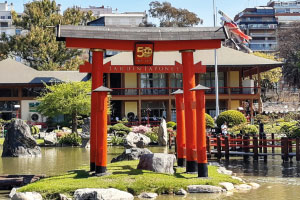 Located in the heart of Palermo, very close to the Bosques de Palermo, it is a space of harmony that cuts through the bustle of the city. It is like entering a world of Japanese fantasy. Without a doubt, we believe that you are going to fall in love with this wonder, so we recommend you go early and early. In this way, you will not be in a hurry and you can walk calmly throughout its interior.
Located in the heart of Palermo, very close to the Bosques de Palermo, it is a space of harmony that cuts through the bustle of the city. It is like entering a world of Japanese fantasy. Without a doubt, we believe that you are going to fall in love with this wonder, so we recommend you go early and early. In this way, you will not be in a hurry and you can walk calmly throughout its interior.
Its trees are charming, and the entire structure of the garden is ornamented with traditional elements from Japan. It has native trees such as Tipa and Palo Borracho, and also a great variety of typical Japanese plants such as sakura and azaleas.
Another note of color is that in the lagoon you will find the typical Koi fish and carp of various colors.
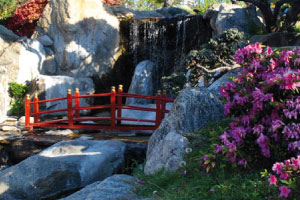 All its elements seek balance and harmony. The bridges inside are symbols, such as the Bridge of God, curved and representing the way to paradise; the Truncated Bridge, which leads to the island of miraculous remedies, and the Bridge of decisions or Zig Zag Bridge.
All its elements seek balance and harmony. The bridges inside are symbols, such as the Bridge of God, curved and representing the way to paradise; the Truncated Bridge, which leads to the island of miraculous remedies, and the Bridge of decisions or Zig Zag Bridge.
In addition to its garden, it has a building that is a center for Japanese cultural activities for everyone who likes it. Also, it has an exhibition about their culture, with kimonos, paintings, origami and more. It has a typical Japanese restaurant to enjoy this delicious food, and a nursery to buy various plants and food for Koi fish, since it is forbidden to throw food at them that is not suitable. For those of us who like to have souvenirs, rest assured that there is a store with a variety of Japanese items where you will want to buy everything! It also has a Chashitsu (tea house), it is a space specially built to experience the traditional Japanese tea ceremony.
Here we leave you their website so that you can purchase the tickets.
The city of Buenos Aires has many attractions, activities and must-see places like this one. In this note, we tell you about several different plans to enjoy a day outdoors in this wonderful city!
Carlos Thays Park, in the heart of Recoleta and very close to many other activities, which we tell you in this other note to enjoy Buenos Aires outdoors!
This large park has 4500m2 (more than 4 hectares), and bears this name in honor of the well-known Landscape Architect Carlos Thays.
 A characteristic that distinguishes it and differentiates it from the other parks is that it is one of the few that has a great variety of sculptures. Here, you will find outstanding works by great and well-known artists such as Marta Minujín (“United Nations“); the plastic artist Fernando Botero (“Male Torso“); the Italian sculptor Alejo Afani (“Pro National Culture“); among many others.
A characteristic that distinguishes it and differentiates it from the other parks is that it is one of the few that has a great variety of sculptures. Here, you will find outstanding works by great and well-known artists such as Marta Minujín (“United Nations“); the plastic artist Fernando Botero (“Male Torso“); the Italian sculptor Alejo Afani (“Pro National Culture“); among many others.
Entrance is free and open!
Located on Av. Figueroa Alcorta and Av. Callao, it is very close to some bars to enjoy a picnic in the open air and, later, to be able to go for a drink in the same area. Also, it is a few steps from the Law School, the National Museum of Fine Arts, the Floralis Genérica and the Recoleta Cemetery.
It is truly a beautiful green space to enjoy a bit of the outdoors, close to many other attractions so you can plan a whole day in Recoleta. For more information, read this other note about this magnificent and picturesque neighborhood of Buenos Aires.
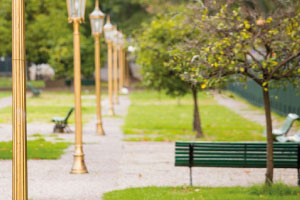 What we do ask you is that, if you consume something in the park, then take your garbage to the nearest bin, to preserve the place. Preserving green spaces is everyone’s job!
What we do ask you is that, if you consume something in the park, then take your garbage to the nearest bin, to preserve the place. Preserving green spaces is everyone’s job!
-Don’t let his name confuse you! There are other spaces that bear the name of this renowned landscaper, such as the Botanical Garden.
-Here we leave you the map so you can see where it is and everything that you have nearby!
Ecopark in Buenos Aires, formerly known as the Palermo Zoo, which was closed and modified in 2016.
You may wonder what happened to all the species of animals that lived in that place… those that were in conditions of disease and / or rehabilitation are those that continued on this site (some are still waiting to be released to this day), and the rest were relocated to more suitable places for their animal life.
 It is a park open to the public in the heart of Palermo. Located at Av. Sarmiento and Av. Las Heras, it is in charge of the Ministry of the Environment and Public Space of the City. Several Special Projects have been created for animal care.
It is a park open to the public in the heart of Palermo. Located at Av. Sarmiento and Av. Las Heras, it is in charge of the Ministry of the Environment and Public Space of the City. Several Special Projects have been created for animal care.
It is an open-air space with 16.7 hectares, suitable for the whole family, dedicated to environmental education through recreational and immersive experiences.
Here, you can learn about caring for animals and natural environments, through educational and recreational experiences, as well as technology through virtual reality.
Currently, only 50% of the park is open to the public, since the rest continue in works of heritage recovery, readjustment of spaces and other works that add to animal welfare.
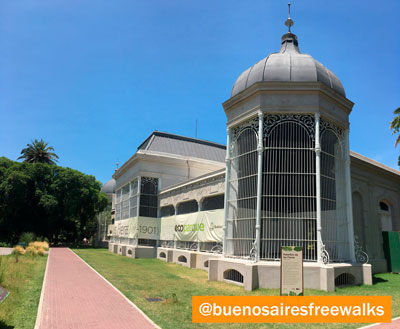 The entrance to the park is through Av. Sarmiento 2601 and its hours are from Wednesday to Sunday (and holidays), from 10 am to 5 pm. Closed due to rain!
The entrance to the park is through Av. Sarmiento 2601 and its hours are from Wednesday to Sunday (and holidays), from 10 am to 5 pm. Closed due to rain!
Given the situation of COVID’19, it has a maximum capacity of 500 people and, upon entering, the staff will take their temperature. Likewise, the use of a mask is mandatory to access.
Entrance is for free!
So, if you want to know a little more about the environment, the species and enjoy a day outdoors, this Ecopark is a wonderful option!
We leave you their website here for more information.
Also, we bring you this note to see other parks to which you can walk from here!
Map of Location
Tigre is one of the most popular destinations for porteños to spend a day outdoors. Whether in summer or winter, contact with nature gives us multiple landscapes. One of the great advantages of Tigre is that it is very close to the city of Buenos Aires.
Next, we will share what to do in Tigre, a review of the best activities.
How to travel to Tigre
First of all, we must know how to get to Tigre. For this, we invite you to read this complete note that details the different ways to travel to Tigre with public transport (train, bus) and even bicycle.
Once they arrive, they can enjoy the following activities:
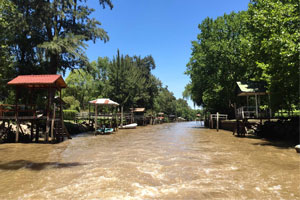 Without a doubt, the main attraction in Tigre is the Delta. The Delta forms at the mouth of one or more rivers. The rivers have been dragging sediments throughout their journey and when they reach ocean level, they lose their capacity to transport them. For this reason, these sediments are deposited in the river beds. This is how islands and small rivers in the shape of labyrinths are formed.
Without a doubt, the main attraction in Tigre is the Delta. The Delta forms at the mouth of one or more rivers. The rivers have been dragging sediments throughout their journey and when they reach ocean level, they lose their capacity to transport them. For this reason, these sediments are deposited in the river beds. This is how islands and small rivers in the shape of labyrinths are formed.
From the port of Tigre, a few blocks from the transport stations, there are multiple river services that run through the Delta. You can choose a small or large boat. No need to make reservations. The ticket is bought at the river station.
It is also possible to take a boat to a spa and spend the day there. There are many bars and restaurants offering the different meals of the day. You can search Google Maps and find one of your liking.
Another option, if you have more time, is to spend the night in the Delta. It is a very nice experience to spend a few days in contact with nature. In airbnb you can find many cabins that are rented for the night.
 For those who want to do a bit of sport, a very good option is to go on a Kayak tour. There are many companies that offer the service, either for rent or for a ride. Keep in mind that, to rent, you need experience because it is a very busy area.
For those who want to do a bit of sport, a very good option is to go on a Kayak tour. There are many companies that offer the service, either for rent or for a ride. Keep in mind that, to rent, you need experience because it is a very busy area.
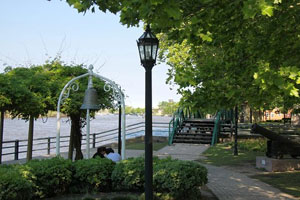 A few blocks from the transport station, the Paseo Victorica begins, a beautiful route on the banks of the Luján River. They are a little more than 10 blocks to enjoy the view of the river. There you can sit in one of the restaurants to eat or drink something or just enjoy the view sitting on a public bench.
A few blocks from the transport station, the Paseo Victorica begins, a beautiful route on the banks of the Luján River. They are a little more than 10 blocks to enjoy the view of the river. There you can sit in one of the restaurants to eat or drink something or just enjoy the view sitting on a public bench.
On the way, you will also see two museums: the Naval Museum and the Tigre Art Museum.
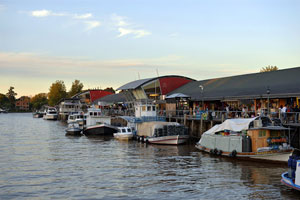 The Puerto de Frutos is a market that has changed over the years. It carries that name because in the beginning, exclusively Fruits and Vegetables that came from the Paraná River were sold by boat.
The Puerto de Frutos is a market that has changed over the years. It carries that name because in the beginning, exclusively Fruits and Vegetables that came from the Paraná River were sold by boat.
Today, although it is still possible to buy some fruit or vegetables, it has become a very varied market. There are handicrafts, many wooden products and even places to eat.
After visiting the Delta, you can take a few minutes, take a tour of the market and take a souvenir.
Here we leave you more information!
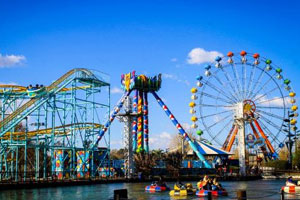 If the adrenaline of the boats or kayaks was not enough, you can try spending a few hours in the Parque de la Costa Amusement Park.
If the adrenaline of the boats or kayaks was not enough, you can try spending a few hours in the Parque de la Costa Amusement Park.
It is advisable not to go in high season as there are many lines for the different attractions.
If you want to take a tour or some activity in this beautiful place, we leave you the contact of our friends who can help you:
SOLEDAD: +54 9 11 5102-1023
MARINA: +54 9 11 5639-6013
A Visit to the Block of Enlightenment, a fantastic plan for a day in San Telmo neighborhood.
The Block of Enlightenment (La Manzana de las Luces), a former Jesuit mission, is one of the city’s main historic landmarks, together with the Baroque church of San Ignacio.
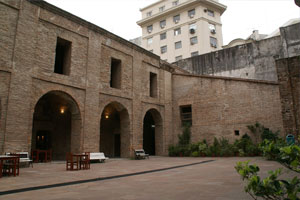 It all started between 1686 and 1722 when the Jesuit monks built the church, and went on adjoining a school, a museum, a library, administrative offices and the city’s first chemist.
It all started between 1686 and 1722 when the Jesuit monks built the church, and went on adjoining a school, a museum, a library, administrative offices and the city’s first chemist.
When Spain suppressed the order of the Jesuits, the whole complex was transformed. The school was turned into the Royal College of San Carlos (today’s Colegio Nacional de Buenos Aires), the church became a cathedral, and Argentina’s first medical college was opened in the old chemist.
In 1780, the Spanish Viceroy Juan José de Vértiz established the city’s first printing press at the site, as well as an orphanage.
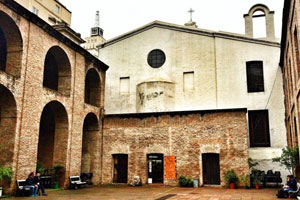 The most interest thing of the Block of Enlightenment is the network of underground tunnels beneath the building. They are believed to have served as a storage place for ammunitions during Argentina’s Independence War.
The most interest thing of the Block of Enlightenment is the network of underground tunnels beneath the building. They are believed to have served as a storage place for ammunitions during Argentina’s Independence War.
There are guided tours available in Spanish for ARS$150 (2 USD). Contact the museum for further details.
Currently, the guided tours are canceled due to the situation of the COVID-19 virus, for which certain visit protocols have been modified. Before the pandemic situation, the guided tours were in Spanish for ARS $ 150 (2 USD) February 2020.
We leave the museum website here for more information.
Contact
? Perú 294, CABA
? +54 (011) 4342-9930 / 6973
? Mon a Fri – 11 a 19 hs
Sat, Sun, y Holidays – 13 a 19hs
Check information on the museum’s website before going.
We leave you the map to check how to get there!
Grave of Evita Perón is one of the most visited tombs of the cemetery of Recoleta. In fact, it is usual to find fresh flowers for her.
Nevertheless, many of the tourist who visit the grave know too little about this character of our history and most of their knowledge comes from Andrew Lloyd Weber’s musical with Madonna in the role of Evita.
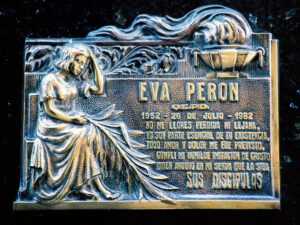 So, here you are. Short and sweet, what you need to know about Eva Perón before you visit her resting place.
So, here you are. Short and sweet, what you need to know about Eva Perón before you visit her resting place.
María Eva Duarte de Perón was born in 1919 on a poor family in La Pampa. She moved to Buenos Aires at the age of 15 to pursue her acting career. She met Juan Domingo Perón and became his wife.
She was the First Lady of Argentina from 1946 until her death in 1952. She got very involved in politics and defended the socialist cause. She spoke on behalf of labour rights, she championed women’s suffrage and ran the Women’s Peronist Party.
Evita is loved by many Argentinians, but she is also deeply hated.
Her critics argue that the Perón matrimony used their political power to indoctrinate children, threaten businessmen and incarcerate their political opponents.
To know more about her and learn what was done with her corps join at our Recoleta Cemetery Tour.